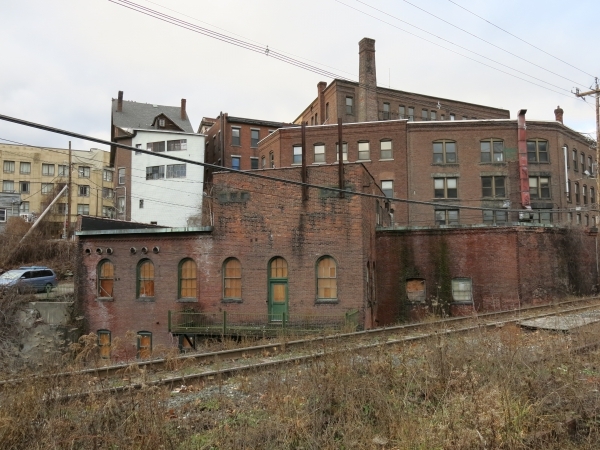BRATTLEBORO — The Brattleboro Museum & Art Center's plans to convert an abandoned downtown industrial building into an arts space got a big boost this week.
On June 1, BMAC Director Danny Lichtenfeld announced the museum received a $200,000 grant from the U.S. Environmental Protection Agency's Brownfields Program to clean up the neglected property at 11 Arch St.
The BMAC purchased the building from Green Mountain Power in December 2015 to expand the museum's arts and programming space.
“We have some exciting new programs and we need some more space in order to do them,” Lichtenfeld said.
But there is no feasible way to build an addition onto the BMAC's home at Union Station. The Arch Street building, located across the Whetstone Brook from the museum, “is as adjacent as property gets,” Lichtenfeld said.
Plus, “it's a cool old building,” he added.
When museum officials considered buying the building, they knew decontamination and renovation costs would be substantial. The low purchase price - $1 - helped them decide to move forward.
EPA encouragement also helped.
Second time's a charm
Lichtenfeld said officials with the agency initially told him the Arch Street project had an excellent chance of getting grant funding. But the museum was rejected in the first go-round in 2015. “They said we were barely rejected, and they gave us suggestions on how to improve our application,” Lichtenfeld said.
Because this is an annual grant, the project had to wait another year. This time, the museum was successful.
Lichtenfeld said he was grateful to the Vermont Congressional delegation for their hard work in support of the EPA and its grant programs.
In a news release, Lichtenfeld thanked Susan McMahon of the Windham Regional Commission and Alan Liptak and Angela Emerson of LE Environmental in Waterbury, Vermont, “for their help in developing the cleanup plans that served as the basis of our grant application."
“I want to emphasize this money that's coming to the museum that benefits the Brattleboro community comes from an amazing program” - the EPA's Brownfields Program - “and this is from last year's budget,” Lichtenfeld said - which was set during the final year of the Obama administration.
He pointed out this funding isn't from the Trump administration's budget, and “I hope this program sticks around,” Lichtenfeld said.
“I can't imagine who, in their right mind, doesn't think this is a good use of federal money,” Lichtenfeld said. “How is this a partisan issue?”
He characterized the Arch Street clean-up project as a community service beyond the needs of the museum and its patrons.
“You have this contaminated building in an amazing spot, right at the foot of Main Street, with this rushing waterfall,” Lichtenfeld said, adding it's one of the first things a visitor crossing the Brattleboro-Hinsdale Bridge sees upon arriving in town.
Historic intersection
Because the museum is a nonprofit and has access to grant funding, Lichtenfeld said BMAC can clean up the building and improve the health, safety, and beauty of that section of town.
If the museum's officials ultimately decide the building doesn't suit their needs, it will still get cleaned up, making it a viable option for further development.
The building at 11 Arch Street lies at the intersection of Brattleboro's industrial history and its geography.
In its former life, the building housed a grist mill, an electrical power generator and substation, and a machine shop. But not all of the industrial toxins on-site are from its own activity.
“Most of the [remaining] contamination is from ground water under the property coming from other properties” in town, Lichtenfeld said. The property sits on some of the lowest elevation in town, astride the Whetstone Brook, blocks away from the sites of former dry cleaners, gas stations, tanneries, and factories - many of which inadvertently sent their industrial toxins to the soil beneath and around 11 Arch Street.
But on the scale of brownfield contamination clean-ups, this one isn't so bad, Lichtenfeld said.
The building “is really not a mess, it's in really good shape,” partly because previous owners did some decontamination work.
What's left is removing or capping soil contaminated with polycyclic aromatic hydrocarbons, heavy metals, perchloroethene, and PCBs, and getting rid of some lead paint and asbestos in the building.
Lichtenfeld said it is still too early to announce the museum's plans for 11 Arch St. - including renovation costs.
Currently, he and his staff are conducting a funding feasibility study to try to nail down what the plans will cost and where the money will come from. He expects to announce the museum's intentions for 11 Arch St. at the end of the summer.
“We've dreamed up some really amazing plans, but right now we're in the process of figuring out which version we can do,” Lichtenfeld said.
